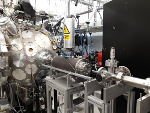| Version 6 (modified by , 7 years ago) ( diff ) |
|---|
SmartPhantom: design meeting
Meeting: 15Apr19; 11:00 BST
Meeting details
Teleconference: phone details:
UK: 08082 380274 Austria: 0800 006612 PIN: 5904750902
Full list of telephone contacts may be found here.
Agenda:
- Outline concept and desired timeline: KL
- Expected performance from simulation: HTL
- Discussion: concepts for mechanical implementation: All
- Discussion: concepts for digitisation and readout: JB/All
- Actions and next steps
Notes
Present: KL, JT, JB, AK Apologies: HTL
- Outline concept and desired timeline: KL
- A summary of the design of the SmartPhantom was presented. The desired timeline is that the device is ready for implementation at MedAustron in October 2019.
- Expected performance from simulation: HTL
- HTL's simulation of the SmartPhantom was discussed. We noted that the rates estimated meant that it would not be possible to sample each particle. In addition the amount of light expected is large.
- We discussed the necessity of sampling with 100% efficiency and whether mechanical simplification could be achieved by a less closely packed arrangement of fibres was adopted. A particular avantage of a more sparse implementation would be that the fibres could be read out using a clear fibre with a larger diameter making the precision of the scintillating-to-clear transition less stringent. HTL's simulation appears to be ready to address such questions of design and performance.
- We agreed that doublet layer arrangement specified in the documentation would be used as the baseline as this preserves the position accuracy of the device.
- Questions for HTL:
- How was convertion of partices/spill to n-photo-electrons done?
- Note added: the energy deposited into a fibre was converted to a number of photo-electrons (nPE) using a constant tuned to the MICE situation. The expected number of photo-electrons observed was then sampled from a Poisson distribution with a mean equal nPE.
- What is the performance fall off observed if a less closely-packed arrangement of fibres is dopted?
- How was convertion of partices/spill to n-photo-electrons done?
- Discussion: concepts for mechanical implementation: All
- JT will work with a graduate engineer to develop design. First need to agree scope of work. Need to include:
- Desigh of doublet layer, manufacturing concepts;
- Mating of scintilatting and clear fibres;
- Support and positional arrangements in water phantom;
- Bundling of clear fibre; and
- Mechancial connection from fibre bundle to camera.
- Will need to agree:
- Flatness specification for optical connector surfaces;
- Tolerance on fibre mating. To determine this need to consider:
- Fibre packing, thickness of the cladding , and acceptance of light (opening angle on exit from the fibre)
- JT will work with a graduate engineer to develop design. First need to agree scope of work. Need to include:
- Discussion: concepts for digitisation and readout: JB/All
- Bespoke image sensor solution unlikely to be possible on required timescale. So, propose a development of the AK scheme that uses a camera to image the fibre bundle.
- Advantage of this approach is that light attenuation is possible.
- Disadvantage is the likely number of fibres that can be seen by one camera and the reduction in r/o speed.
- Actions and next steps
- We discussed what a reasonable schedule could look like and agreed:
- Mechanical:
- Concept development to end May (phone and email);
- Construction start for first plane May/Jun boundary;
- Electronic:
- Investigate camera used for the SciWire;
- Implement first camera r/o system with first prototype plane.
- Mechanical:
- HTL will, over time, take the lead in completing the specification and coordinating the design, manufacture, and commissioning. In the short term, contact will be maintained by phone and email.
- A short-term goal will be to organise a meeting with the graduate engineer as soon as agreement has been reached on progressing the project within TD and PPD.
- We discussed what a reasonable schedule could look like and agreed:
Attachments (3)
-
SmartPhantom.pdf
(1.7 MB
) - added by 7 years ago.
Initial design description
-
2019-04-15-LAU-simulation.pdf
(502.4 KB
) - added by 7 years ago.
HT Lau presentation
-
Z0-Phone-details.pdf
(165.4 KB
) - added by 7 years ago.
Teleconference details
Download all attachments as: .zip
Note:
See TracWiki
for help on using the wiki.
